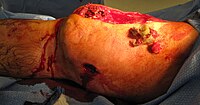
Photo from wikipedia
INTRODUCTION Abusive head trauma (AHT) is defined as an injury to the skull or intracranial contents due to inflicted blunt impact and/or shaking. It is characterized by the triad: encephalopathy,… Click to show full abstract
INTRODUCTION Abusive head trauma (AHT) is defined as an injury to the skull or intracranial contents due to inflicted blunt impact and/or shaking. It is characterized by the triad: encephalopathy, retinal haemorrhages and subdural hematoma. The main objective is to know the epidemiological, clinical and radiological characteristics; as well as the short and long term outcomes of patients diagnosed with AHT. PATIENTS AND METHODS It is a descriptive, observational and retrospective study of the 19 patients diagnosed with AHT at a tertiary hospital from 1990 to 2018, both included. RESULTS The mean age of the patients was 5,5 months with parity between both sexes. The principal medical histories reported were: absence of trauma (n = 9), history of a short fall (n = 6) and shaking (n = 4). The most frequent initial presentation was severe, and seizures was the main symptom (n = 8). Retinal haemorrhages were present in fifteen patients and subdural hematoma or hygroma in fifteen patients. Two patients died, seven presented short-term outcomes, and ten of the twelve patients who were performed a follow-up presented long-term outcomes. These outcomes were manifested as cognitive or behavioural disorders (n = 5) or as neurological disorders (n = 6). CONCLUSIONS The epidemiological, clinical and radiological characteristics found are very similar to those reported in the literature. The prevalence of outcomes is high and they appear as cognitive or behavioural disorders.
Journal Title: Revista de neurologia
Year Published: 2022
Link to full text (if available)
Share on Social Media: Sign Up to like & get
recommendations!